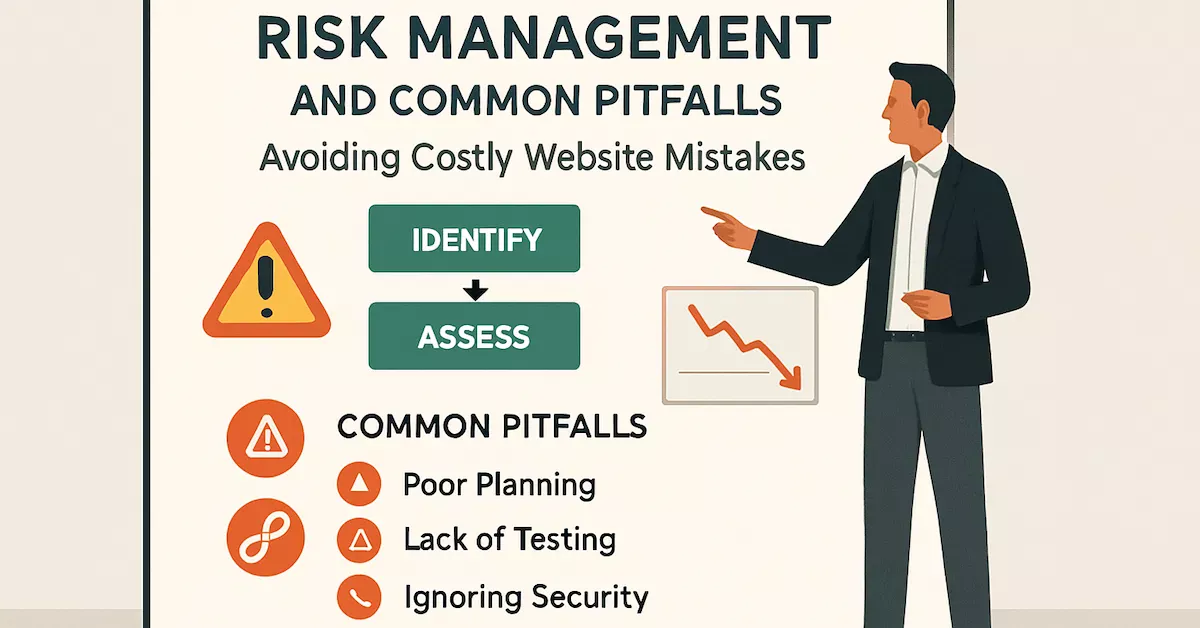
Why Risk Management Matters
Launching a website can be an exciting step for your small business, but it’s also a project fraught with potential pitfalls. Failing to anticipate and manage these risks can lead to wasted time, budget overruns, and a website that doesn’t meet your business goals.
Risk management isn’t about being pessimistic; it’s about being prepared. By identifying potential problems early and having a plan to address them, you can minimise disruptions, stay on track, and ensure your website project is a success.
This page outlines some of the most common mistakes small businesses make when building a website, and provides practical advice on how to avoid them.
Common Pitfalls
Not Setting Clear Goals
Without clear, measurable goals, it’s impossible to know if your website is successful. Vague goals like “increase brand awareness” are difficult to track and don’t provide a clear direction for your project.
Underestimating Content Needs
Many businesses underestimate the amount of time and effort required to create high-quality, engaging content for their website. This can lead to rushed, poorly written content that doesn’t resonate with your audience.
Ignoring Mobile Users
In today’s mobile-first world, a website that isn’t optimised for mobile devices is a major turnoff. If your website doesn’t look and function well on smartphones and tablets, you’ll lose potential customers.
Skipping Testing
Failing to thoroughly test your website before launch can lead to embarrassing errors, broken features, and a poor user experience.
Neglecting Security
A website that isn’t properly secured is vulnerable to hacking, malware, and data breaches. This can damage your reputation, compromise customer data, and lead to legal liabilities.
Forgetting Legal Requirements
Websites must comply with various legal requirements, such as privacy policies, terms and conditions, and accessibility standards. Failing to comply can result in fines and legal action.
Not Budgeting for Ongoing Costs
Many businesses focus on the initial cost of building a website and forget to budget for ongoing expenses like hosting, maintenance, security, and marketing.
Poor Communication with Contractors
If you’re outsourcing any part of your website project, poor communication with contractors can lead to misunderstandings, delays, and unsatisfactory results.
How to Avoid Them
Set Clear, Written Goals
Define specific, measurable, achievable, relevant, and time-bound (SMART) goals for your website.
- Example: “Increase online sales by 20% in the next quarter,” or “Generate 50 new leads per month through our contact form.”
Make a Content Checklist
Before you start building your website, create a detailed content checklist outlining all the content you need, including website copy, blog posts, images, videos, and downloads.
Always Test on Mobile
Ensure your website is responsive and looks and functions well on all devices, including smartphones and tablets. Use Google’s Mobile-Friendly Test to check your website’s mobile-friendliness.
Use a Launch Checklist
Create a launch checklist to ensure you’ve covered all the essential steps before making your website live, including testing, security, legal compliance, and analytics.
Keep Software Updated
Regularly update your website’s software, plugins, and themes to ensure security and functionality. Enable automatic updates whenever possible.
Have Clear Contracts and Agreements
If you’re outsourcing any part of your website project, have clear contracts and agreements with your contractors outlining the scope of work, deliverables, timelines, and payment terms.
Plan for Ongoing Costs
Create a budget for ongoing website expenses, including hosting, maintenance, security, marketing, and content creation.
What to Do If Things Go Wrong
Even with careful planning, things can still go wrong. Here’s how to handle some common website problems:
How to Recover from a Failed Launch
If your website launch doesn’t go as planned, don’t panic.
- Identify the problems: What went wrong? Was it a technical issue, a content error, or a marketing failure?
- Fix the issues: Address the problems as quickly as possible.
- Communicate with your audience: Apologise for any inconvenience and let them know what you’re doing to fix the issues.
- Re-launch: Once the problems are resolved, re-launch your website with a new marketing campaign.
What to Do If Your Site Is Hacked
If your website is hacked, take immediate action to contain the damage.
- Contact your hosting provider: They can help you identify the source of the attack and restore your website from a backup.
- Change all passwords: Change all passwords for your website, hosting account, and email accounts.
- Scan for malware: Use a security scanner to identify and remove any malware from your website.
- Notify your customers: If customer data has been compromised, notify your customers as soon as possible.
How to Handle Negative Feedback
Negative feedback is inevitable, but it’s also an opportunity to improve your website and customer service.
- Respond promptly and professionally: Acknowledge the feedback and thank the customer for their input.
- Investigate the issue: Find out what went wrong and why the customer was unhappy.
- Offer a solution: If possible, offer a solution to the customer’s problem.
- Learn from the feedback: Use the feedback to improve your website, products, or services.

Example:
Gumnut Growth Centre almost made a costly mistake when they forgot to include a privacy policy on their website. A sharp-eyed customer pointed out the omission, and Gumnut Growth quickly added a policy to comply with Australian privacy laws. They learned a valuable lesson about the importance of legal compliance and now have a checklist to ensure they don’t make the same mistake again.
By anticipating potential risks and having a plan to address them, you can minimise disruptions, stay on track, and ensure your website project is a success. Don’t be afraid to ask for help from experienced professionals if you need it.